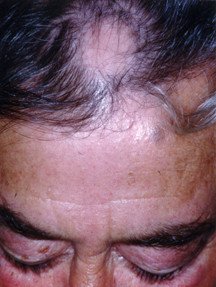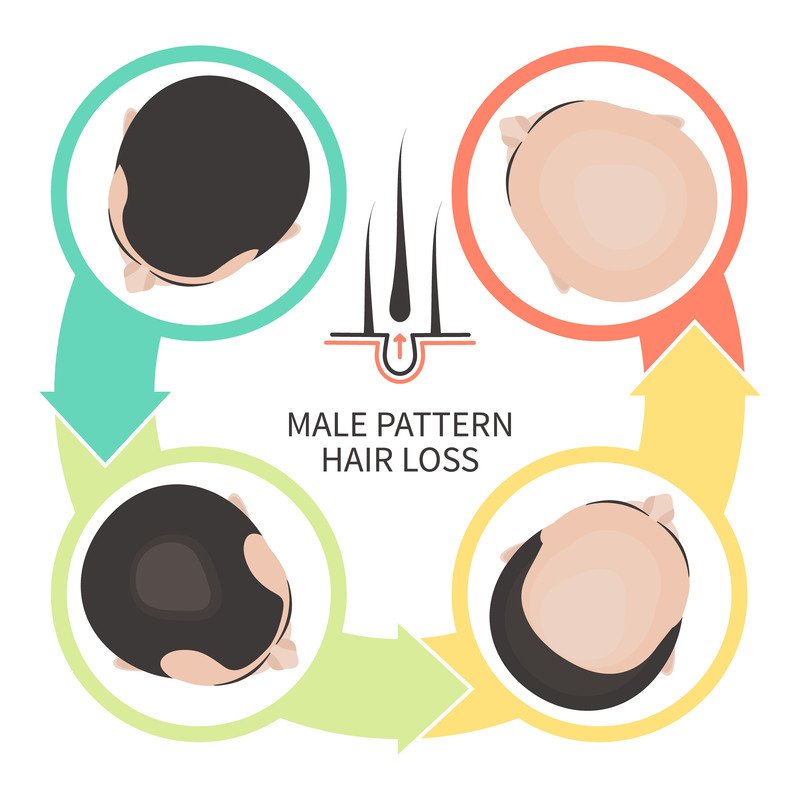Hair loss
Medically reviewed by Drugs.com. Last updated on Jan 3, 2024.
What is Hair loss?

Hair loss can range from mild hair thinning to total baldness. Hair can fall out for many different reasons. Medically, hair loss falls into several categories, including:
- Telogen effluvium — This common form of hair loss happens two to three months after a major body stress, such as a prolonged illness, major surgery or serious infection. It also can happen after a sudden change in hormone levels, especially in women after childbirth. Moderate amounts of hair fall out from all parts of the scalp, and may be noticed on a pillow, in the tub or on a hairbrush. While hair on some parts of the scalp may appear thinner, it is rare to see large bald spots.
- Drug side effects — Hair loss can be a side effect of certain medications, including lithium, beta-blockers, warfarin, heparin, amphetamines and levodopa (Atamet, Larodopa, Sinemet). In addition, many medications used in cancer chemotherapy — such as doxorubicin (Adriamycin) — commonly cause sudden hair loss affecting the entire head.
- Symptom of a medical illness — Hair loss can be one of the symptoms of a medical illness, such as systemic lupus erythematosus (lupus), syphilis, a thyroid disorder (such as hypothyroidism or hyperthyroidism), a sex-hormone imbalance or a serious nutritional problem, especially a deficiency of protein, iron, zinc or biotin. These deficiencies are most common in people on restrictive diets and women who have very heavy menstrual flow.
- Tinea capitis (fungal infection of the scalp) — This form of patchy hair loss happens when certain types of fungi infect the scalp. This causes the hair to break off at the scalp surface and the scalp to flake or become scaly. Tinea capitis is a common form of patchy hair loss in children.
- Alopecia areata — This is an autoimmune disease that causes hair to fall out in one or more small patches. The cause of this condition is unknown, although it is more common in people who have other autoimmune diseases. When the same process causes total loss of hair from the scalp it is known as alopecia totalis.
|
|
- Traumatic alopecia — This form of hair loss is caused by hairdressing techniques that pull the hair (tight braiding or cornrowing), expose hair to extreme heat and twisting (curling iron or hot rollers) or damage the hair with strong chemicals (bleaching, hair coloring, permanent waves). In addition, some people have an uncommon psychiatric disorder (trichotillomania) in which compulsive hair pulling and twisting can cause bald spots.
- Hereditary pattern baldness, or androgenetic alopecia — In men, hair loss may follow the typical male pattern (receding front hairline and/or thinning hair at the top of the head). This is the most common type of hair loss, and it can begin at any time in a man's life, even during his teen years. It usually is caused by the interaction of three factors: an inherited tendency toward baldness, male hormones and increasing age. Many women will develop some degree of female-pattern baldness. In women, thinning occurs over the entire top or crown of the scalp, sparing the front of the scalp.
|
|
Symptoms
We normally lose approximately 50 to 100 scalp hairs each day. If more than this is falling out, you may find unusually large amounts of hair in brushes, on clothing, and in the drains of sinks and tubs. You may also notice that your hair is generally thinner, that your part is wider, that your hairline has changed or that one or more bald patches have appeared.
When hair loss is the result of telogen effluvium or medication side effects, the hair loss usually is all over the head, while in tinea infections and alopecia areata, the hair loss occurs in small patches. Also, tinea infections can cause additional symptoms, such as scaling of the scalp or areas of broken hairs that look like black dots. In traumatic alopecia, the area of hair loss depends on the method of hair injury and follows the pattern inflicted by hot rollers, braiding or chemical treatments. In male-pattern baldness, the hairline usually begins to recede at the temples first, followed by thinning at the top of the head. Gradually, the crown area becomes totally bald, leaving a fringe of hair around the back and sides of the head.
Diagnosis
Your doctor will diagnose the cause of your hair loss based on your medical history, the medications you take, your nutritional status, your hairdressing habits and a physical examination. If your doctor suspects a fungal infection of your scalp, he or she may take a hair sample for laboratory testing. Blood tests probably will be needed if your doctor suspects a medical illness (such as lupus) or a thyroid problem, iron deficiency or sex-hormone imbalance.
Expected duration
How long hair loss lasts depends on the cause. In telogen effluvium, for example, hair usually is lost over several weeks to months, but then grows back over the next several months. When hair loss is a side effect of a medication, hair growth usually returns to normal once the drug is stopped. If you are losing hair because of abusive hairdressing, the hair loss usually stops after you change to more natural styling, except in traction alopecia, which results from years of pulling the hair back in tight braids. In tinea scalp infection, the fungus that causes the problem must be treated for at least 6 to 12 weeks and hair regrowth may be slow. Early treatment is important in preventing possible permanent hair loss. Both male- and female-pattern baldness tend to get worse over time but can be treated.
Prevention
Some forms of hair loss can be prevented by minimizing stress, eating a healthy diet and using sensible hairdressing techniques, and, if possible, switching to medications that do not cause hair loss. Hair loss from fungal infections can be prevented by keeping hair clean and by never sharing hats, combs or brushes with other people. Hair loss from hereditary-pattern baldness can sometimes be prevented by medication.
Treatment
Hair loss resulting from telogen effluvium or drug side effects usually requires no treatment other than discontinuing the medication that is causing the problem. Limiting trauma or chemical exposure (such as use of a blow dryer, hair straightener, coloring or perms) may limit or stop hair loss. Hair loss from poor nutrition or medical illness usually stops with the adoption of a healthy diet and treatment of the underlying medical condition. Treatment of fungal scalp infection requires 6 to 12 weeks of oral medication, such as terbinafine (Lamisil) or itraconazole (Sporanox), with or without shampoos containing selenium sulfide (Selsun Blue, Head & Shoulders, others) or ketoconazole (Nizoral). Alopecia areata can be treated with a corticosteroid that is injected or applied to the skin. Other treatments for this condition include anthralin cream (Drithocreme, DrithoScalp, Psoriatec), minoxidil (Loniten, Rogain) or a combination of these therapies.
Many men and women with hereditary-pattern baldness do not seek treatment for hair loss. For those who do seek medical treatment, initial therapy is usually topical minoxidil (Rogaine). Men can also be treated with oral finasteride (Propecia, Proscar) or dutasteride (Avodart) or they can choose hair transplants or scalp-reduction surgery. Premenopausal women may be treated with estrogen or spironolactone while finasteride may be recommended for postmenopausal women.
Treatment options
The following list of medications are related to or used in the treatment of this condition.
When to call a professional
Call your doctor whenever you are concerned about hair loss, especially if you are having other unexplained symptoms.
Prognosis
Many forms of hair loss are either self-limited (telogen effluvium or drug side effects) or respond to treatment with medication (tinea capitis). Even hereditary-pattern baldness tends to improve with treatment. However, treatment must continue indefinitely. In some conditions, hair loss cannot be reversed, especially if scarring has developed (as can happen in lupus-related scalp disease).
Additional info
American Academy of Dermatology
https://www.aad.org/
American Society of Plastic Surgeons
https//www.plasticsurgery.org/
Further information
Always consult your healthcare provider to ensure the information displayed on this page applies to your personal circumstances.


